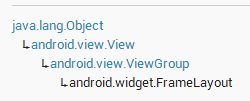昨天学习了LinearLayout,今天来学习FrameLayout布局,其实FrameLayout布局就是在屏幕上开辟一个区域来填充所有的组件,但是所有的组件都是从左上角开始显示(默认显示位置),而且都是层叠显示的,也就是说后面放的叠在前一个上面,具体效果等下看例子,这里同样先看下这个布局的定义(http://developer.android.com/reference/android/widget/FrameLayout.html):
和昨天LinearLayout结构一样,下面来写今天的例子。
效果如下:
main.xml:
<FrameLayout xmlns:android="http://schemas.android.com/apk/res/android"
xmlns:tools="http://schemas.android.com/tools"
android:id="@+id/FrameLayout1"
android:layout_width="match_parent"
android:layout_height="match_parent"
>
<ImageView
android:id="@+id/img"
android:layout_width="wrap_content"
android:layout_height="wrap_content"
android:background="@drawable/img_2" />
<EditText
android:id="@+id/edt"
android:layout_width="wrap_content"
android:layout_height="wrap_content"
android:text="我在button的下面,看见了吗">
</EditText>
<Button
android:id="@+id/but"
android:layout_width="wrap_content"
android:layout_height="wrap_content"
android:text="我在最上面" />
</FrameLayout>
上面程序定义了三个组件:ImageView、EditText和Button,可以看见在FrameLayout的作用下,组件起始位置都在左上角,最先定义的组件就在最小面,所有布局中(FrameLayout)的组件均层叠显示,这就是FrameLayout的效果。
刚才在看FrameLayout的定义时说过它的定义和LinearLayout一样,所以FrameLayout也可以在java文件中定义,下面就通过java代码来实现上面一样的效果。
MianActivity.java:
package com.example.framelayout;
import android.app.Activity;
import android.os.Bundle;
import android.view.ViewGroup;
import android.widget.Button;
import android.widget.EditText;
import android.widget.FrameLayout;
import android.widget.ImageView;
public class MainActivity extends Activity {
@Override
protected void onCreate(Bundle savedInstanceState) {
super.onCreate(savedInstanceState);
// setContentView(R.layout.activity_main);
//新建FrameLayout布局
FrameLayout frameLayout = new FrameLayout(this);
//定义布局管理器高和宽
FrameLayout.LayoutParams params = new FrameLayout.LayoutParams(ViewGroup.LayoutParams.MATCH_PARENT, ViewGroup.LayoutParams.MATCH_PARENT);
//三个view的高宽都是wrap_content
FrameLayout.LayoutParams viewParams = new FrameLayout.LayoutParams(ViewGroup.LayoutParams.WRAP_CONTENT, ViewGroup.LayoutParams.WRAP_CONTENT);
//新建自己需要的三个组件
ImageView img = new ImageView(this);
EditText edt = new EditText(this);
Button but = new Button(this);
//设置和xml文件一样属性
img.setBackgroundResource(R.drawable.img_2);
edt.setText("我在button的下面,看见了吗");
but.setText("我在最上面");
//将组件加入frameLayout中,按xml中的顺序加入ImageView->EditText->Button
frameLayout.addView(img, viewParams);
frameLayout.addView(edt, viewParams);
frameLayout.addView(but, viewParams);
//显示布局
super.setContentView(frameLayout,params);
}
}
运行效果和前面用xml定义的效果是一样的,今天就说到这里了。


























 6878
6878

 被折叠的 条评论
为什么被折叠?
被折叠的 条评论
为什么被折叠?








